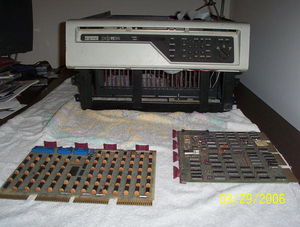PDP-11/34
| PDP-11/34 | |
| Manufacturer: | Digital Equipment Corporation |
|---|---|
| Architecture: | PDP-11 |
The PDP-11/34 was DEC's lower-cost replacement to the PDP-11/40 as the low-end PDP-11 system capable of running time-sharing, using memory management; it had the limited memory management capabilities of the PDP-11/40, though. It was a UNIBUS machine; as such, it was normally limited to 248KB of main memory.
The CPU came in two variants: the KD11-E (M7265 and M7266), and the plug-compatible replacement KD11-EA (M8265 and M8266); machines with the latter were denominated as a PDP-11/34A. Both required the DD11-P backplane.
The latter had provision for the FP11-A floating point unit, and the KK11-A cache (the system could use either, or both).
Both could be provided with either the KY11-LA Operator's Console (a limited functionality console with only halt and boot functionality), or the KY11-LB Programmer's Console.
Apparently it was cloned in the Soviet Union as the SM 1420.
Register access
Like its predecessor PDP-11/05, the general registers (R0-R5, SP and PC) have addresses assigned to them; they are also accessible from the UNIBUS, and therefore from the KY11-LB Programmer's Console, when the machine is halted. Their addresses are:
| Address | Register |
|---|---|
| 777700 | R0 |
| ... | |
| 777705 | R5 |
| 777706 | SP |
| 777707 | PC |
Note that the registers are word-accessible at odd addresses on the UNIBUS (unlike any other device); and their addresses, like those on the -11/05, increment by 1, not by 2, as is usual for word-sized items.
In addition, some internal CPU registers are available at addresses 777710 -777717.
External links
- PDP-11/34 - BitSavers
- PDP-11/34 system user's manual (EK-11034-UG-001)
- PDP1134A power system description (EK-1134A-TM-002)
- 11/34 Vol. 2 Field Maintenance Print Set (MP00082)
- Knob with 3/8 Post & 1/4" D Shaft - replacement power knob
| v • d • e PDP-11 Computers and Peripherals |
|---|
| UNIBUS PDP-11s - PDP-11/20 • PDP-11/15 • PDP-11/35 • PDP-11/40 • PDP-11/45 • PDP-11/50 • PDP-11/55 • PDP-11/70 PDP-11/05 • PDP-11/10 • PDP-11/04 • PDP-11/34 • PDP-11/60 • PDP-11/44 • PDP-11/24 • PDP-11/84 • PDP-11/94 QBUS PDP-11s - PDP-11/03 • PDP-11/23 • PDP-11/23+ • MicroPDP-11/73 • MicroPDP-11/53 • MicroPDP-11/83 • MicroPDP-11/93 QBUS CPUs: LSI-11 • LSI-11/2 • KDF11-A • KDF11-B • KDJ11-A • KDJ11-B • KDJ11-D • KDJ11-E Buses: UNIBUS • UNIBUS map • SPC • MUD • EUB • QBUS • CD interconnect • PMI Also: PDP-11 architecture • PDP-11 Extended Instruction Set • FP11 floating point • PDP-11 Memory Management |
| UNIBUS CPUs: KA11 • KC11 • KB11-A • KB11-B • KB11-C • KB11-D • KD11-A • KD11-B • KD11-D • KD11-E • KD11-EA • KD11-K • KD11-Z • KDF11-U
Co-processors: FP11-A • FP11-B • FP11-C • FP11-E • FP11-F • KE44-A • FPF11 Chips: LSI-11 • KEV11-A • KEV11-B • KEV11-C • F-11 • KEF11-A • KTF11-A • T-11 • J-11 • FPJ11 CPU options: KE11-E • KE11-F • KJ11-A • KT11-C • KT11-D • KK11-A • KK11-B • KT24 • KTJ11-B Rare CPU options: KS11 Memory Protection and Relocation option • KT11-B Paging Option • KUV11 Writeable Control Store Front panels: KY11-A • KY11-D • KY11-J • KY11-LA • KY11-LB • KY11-P More on buses: UNIBUS and QBUS termination • Bus Arbitration on the Unibus and QBUS • CTI BUS PDT-11s - PDT-11/110 • PDT-11/130 • PDT-11/150 CTI PDP-11s - PRO-325 • PRO-350 • PRO-380 Other: FIS floating point • PDP-11 Commercial Instruction Set • PDP-11 stacks • PDP-11 family differences |
